9 Apr 2024
Samantha Taylor emphasises the importance of being vigilant for this condition.

Figure 1. A cat presenting with acute blindness and hyphaema due to hypertension. Image: Tim Knott
Arterial hypertension (or systemic arterial hypertension) is a cause of severe pathology in cats, but is likely underdiagnosed.
Over the past 5 to 10 years, understanding of hypertension and the frequency of systolic blood pressure (SBP) assessment in cats has increased, but opportunities to identify hypertensive cats are likely still missed1,2.
In this article, the author will discuss barriers to measurement of blood pressure assessment in primary care practice, and include tips to improve identification of hypertensive cats before the development of severe clinical consequences.
Untreated hypertension can result in severe clinical consequences, including damage to “target” organs: the kidneys, eyes, central nervous system and heart (called target organ damage or TOD)3.
Hypertensive retinopathy is the most common clinical manifestation of hypertension and cats can present acutely blind (Figure 1), but hypertensive encephalopathy may be missed in older cats, with subtle presentations such as gait abnormalities, partial seizures and even mild behaviour changes that could easily be attributed to other causes such as cognitive dysfunction4.
Hypertension may also contribute to progression of chronic kidney disease (CKD), although that relationship is complex, as many cats with CKD develop hypertension during the disease process. CKD is indeed the most common condition associated with hypertension, with 19% to 65% of cats with the condition also hypertensive3.
Additionally, hyperthyroid cats and those with hyperaldosteronism are at higher risk of hypertension – the former at diagnosis, but also during treatment, even when euthyroid.
Evidence suggests that cats diagnosed as a result of screening of these populations had improved survival compared to those diagnosed when presenting with clinical signs of hypertension1, emphasising the importance of early diagnosis.
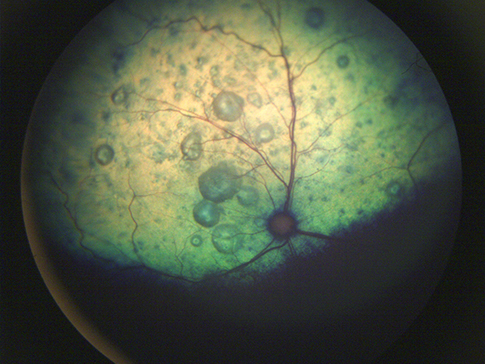
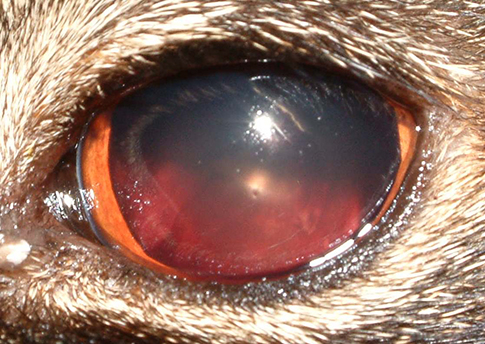
In cats suspected of being hypertensive, vets can gain a huge amount of information from looking in the cat’s eyes, as more than 50% of hypertensive cats may have lesions3, including the majority of cats with hypertensive encephalopathy4. However, 73% of respondents in one study reported struggling to interpret ocular findings2. Evidence of ocular TOD means cats should be promptly treated with anti-hypertensives.
If any doubt exists regarding the SBP readings (for example, they are between 160mmHg to 180mmHg), examining the eyes will provide confirmation that treatment is needed if ocular TOD is present.
Lesions to look for include hyphaema (which can lead to secondary glaucoma), retinal oedema, haemorrhages, detachments (Figures 2a and 2b), and cats may present with blindness. This type of acute onset blindness may be noticed by owners only as reluctance to move, lethargy and inappetence rather than bumping into things; look out for corneal ulcers due to reduced blinking.
A quick and cheap way of examining the retina for changes is distant indirect ophthalmoscopy (Figure 3a). This method of examining the retina is not commonly used, but is very easy, allows a complete view of the retina and can be used to take photographs to then discuss with an ophthalmologist (Figure 3b).
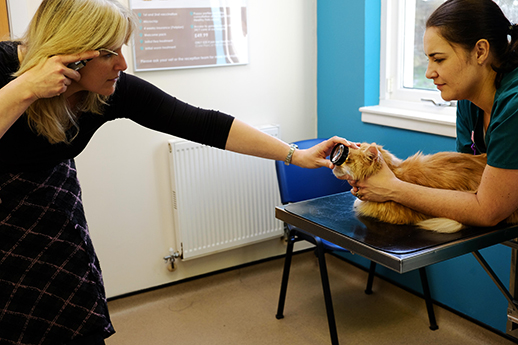
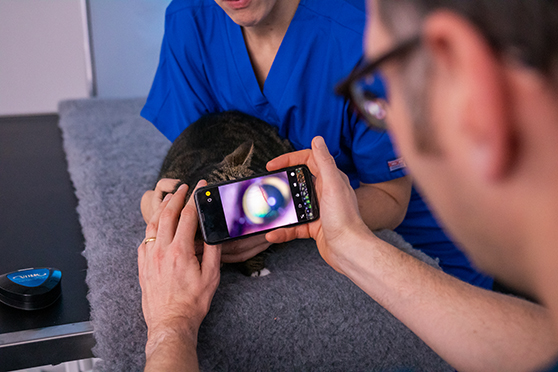
For a guide on using this method and more examples of lesions to look for, see the Ceva online course, “Looking feline hypertension in the eye” (tinyurl.com/3d6t58xm), and see the illustrations in the International Society of Feline Medicine consensus guidelines (tinyurl.com/be699uzu).
Importantly, with treatment cats can recover vision, even if they have suffered complete retinal detachment, but the earlier the diagnosis the better, as cats with a menace response at presentation are more likely to have a normal menace response after treatment compared with those that were blind at diagnosis5.
A recent study examined barriers to the measurement of blood pressure by veterinary professionals. Respondents reported concerns regarding reliability of results (situational or “white coat” hypertension), lack of time for the procedure, equipment frustrations and issues persuading clients to attend appointments for screening blood pressure assessment2. Cost can also be a problem – especially if owners perceive their cats to be healthy.
A huge variety of ways exist of charging for measuring blood pressure (even within practice groups and clinics where charging codes can be applied differently), from being considered part of a physical examination and included in consultation fees, to considerable additional cost as a standalone charge. Generally, combining with other procedures (for example, bloods or urinalysis as part of senior cat health care packages), are better accepted. Acceptance of SBP measurement is certainly improved if owners are less inconvenienced; hence, the reluctance from some to return for a separate appointment.
Strategies to incorporate SBP assessment into the consultation process can include identifying “at-risk” cats (see section “Identifying cats in need of SBP measurement”) and involving the nursing team; for example, all hyperthyroid cats or those with CKD coming in for monitoring could have a nurse appointment firstly for SBP assessment, and vaccination appointments for cats older than 11 years could be combined with a nurse appointment for SBP assessment. No doubt exists that nurses play a vital role in increasing measurement of SBP in cats, and are frequently the team member assessing and promoting SBP measurement2.
Additionally, cats having blood tests as part of a health assessment or when presenting with clinical signs (for example, of hyperthyroidism or CKD) could have SBP measured (and charged) as part of that process (and priced as such). Meeting as a clinic team to discuss overcoming barriers (and considering charging so it is consistently applied) can be hugely beneficial.
Indirect SBP is most commonly measured using a Doppler or oscillometric machines, which have become much more available and affordable in recent years.
Availability of equipment was not identified as a barrier to SBP measurement in a recent study2, but each method has challenges (for example, finding the pulse with a Doppler, or obtaining reliable and consistent readings from an oscillometric machine).
Panel 1 includes tips to improve the accuracy of SBP measurement, whichever method is chosen; also, see the American Association of Feline Practitioners/International Society of Feline Medicine Cat Friendly Veterinary Interaction Guidelines for more information (tinyurl.com/abu7c4vx).
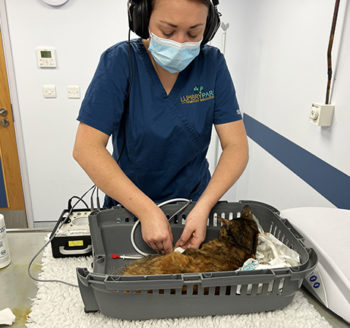
Whichever method is used, equipment needs to be accessible, maintained and staff must be confident to use it. Online or in-person training is often offered by manufacturers, but experienced team members are frequently best placed to train the rest of the team. These skills can then also be applied in theatre and to sick cats and dogs (to identify hypotension), benefiting many patients.
Note that gabapentin is frequently used for anxiolysis in cats visiting veterinary clinics. Current evidence from healthy cats suggests no effect on SBP; however, it is possible that in this population of senior cats and cats with comorbidities such as CKD, gabapentin could reduce SBP. However, it has not been studied in hypertensive patients and further information is needed.
Trying without gabapentin (with cat-friendly techniques) or using the lowest dose possible, plus looking for TOD, can help interpretation of results.
Evidence suggests that SBP is more often measured when cats present with target organ damage1,2, but earlier diagnosis to prevent these serious complications is preferred. Therefore, it is recommended to screen at risk cats in the following groups:
Benefit might exist in starting SBP measurements at younger ages (for example, cats older than seven years) to identify trends and note increases occurring year-on-year. As mentioned previously, as a clinic, it can be useful to look at this list and consider how SBP measurement can be integrated with other assessments, and review if cats with chronic diseases are optimally reassessed; for example, are hyperthyroid cats routinely re-checked every three to six months, even if clinically stable?
Sometimes, this type of audit review can reveal inconsistent advice from different clinicians and missed opportunities for reassessment, while a standard approach may benefit both the clinic and owners – and can be combined with marketing and promotion of initiatives to support senior cats.
Once hypertension is identified (Panel 2), cats should be promptly treated. Choice of anti-hypertensive agents includes amlodipine and telmisartan, and both are licensed in the UK for this indication as Amodip (Ceva) and Semintra (Boehringer Ingelheim), respectively.
Interpreting results and deciding when treatment is needed can be challenging – particularly when cats are anxious – and situational hypertension cannot be excluded. The International Renal Interest Society and American College of Veterinary Internal Medicine (ACVIM) Consensus Guidelines6 classify hypertension based on risk as follows in Table 1.
Hence, the following approach (combining International Society of Feline Medicine and ACVIM recommendations) recommends administration of anti-hypertensive therapy when:
If hypertension is suspected, cats should also be investigated for underlying disease, such as chronic kidney disease.
| Table 1. Blood pressure sub-stages according to the International Renal Interest Society (www.iris-kidney.com) | ||
|---|---|---|
| Systolic blood pressure (mmHg) | Blood pressure sub-stage | Risk of future target organ damage |
| <140 | Normotensive | Minimal |
| 140-159 | Prehypertensive | Low |
| 160-179 | Hypertensive | Moderate |
| ≥180 | Severely hypertensive | High |
Starting dose of amlodipine is 0.125mg/kg to 0.25mg/kg every 24 hours, which can be increased up to 0.5mg/kg every 24 hours if needed. Cats with severe hypertension (for example, SBP more than 200mmHg) may require higher amlodipine doses (for example, 1.25mg/cat every 24 hours), but can respond as well as those with a lower SBP at diagnosis7.
Telmisartan is dosed at 2mg/kg every 24 hours for hypertension, but for cats with concurrent CKD, it makes sense to start at 1mg/kg every 24 hours and monitor response. Very occasionally, response is inadequate and more than one medication is needed, but this is unusual, and a chat with a feline/medicine specialist can be useful in these situations.
Compliance is, of course, vital for success; see Panel 3 for tips on supporting owners.
Owners find it challenging to medicate cats with tablets and liquids8, and medications for hypertension are vital and long term. It is important to support owners and help them consistently give amlodipine and/or telmisartan. Consider the following tips:
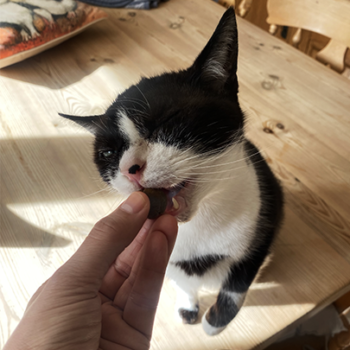
Additional considerations include the following.
“In a busy clinic, it can feel almost impossible to find the time to consistently measure [systolic blood pressure] in at-risk cats. However, the vast majority of clinics now have the equipment needed…”
Cats presenting with severe hypertension (more than 200mmHg; with or without TOD) may benefit from hospitalisation to ensure compliance to medication and to allow re-checking of SBP after 24 hours. However, this should be balanced with stress of hospitalisation and owner finances, and ability to medicate.
For less emergent cases, they are generally better managed at home, with a re-assessment of SBP in 7 to 10 days (at a time when the clinic is quiet, equipment is available and utilising nursing senior cat clinics). The aim of treatment is to reduce the SBP to less than 160mmHg initially and less than 150mmHg longer term.
Once SBP is within the target range, cats should be assessed every three months, as dose adjustments can be needed and concurrent diseases require monitoring. These are senior patients often with CKD and osteoarthritis, so management of all conditions can be balanced to ensure a good quality of life.
In a busy clinic, it can feel almost impossible to find the time to consistently measure SBP in at-risk cats.
However, the vast majority of clinics now have the equipment needed, but might benefit from reviewing how to identify at-risk patients, trying to inform owners of the importance of detecting hypertension, looking at equipment availability, clinic environment and consult times, involving the nursing team, and reviewing pricing structures.
Increasing the number of cats having SBP measured even by a small amount will mean fewer patients suffering severe complications of untreated hypertension.